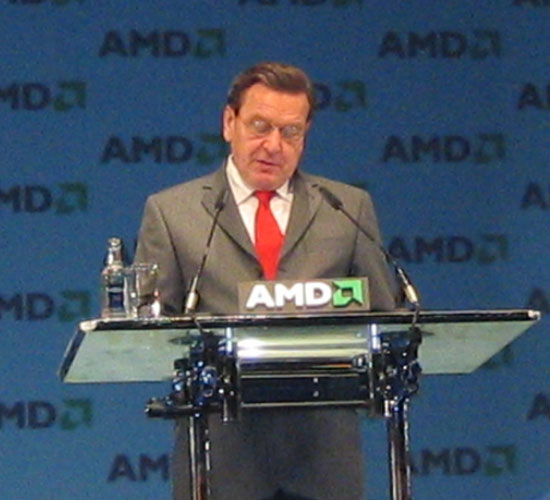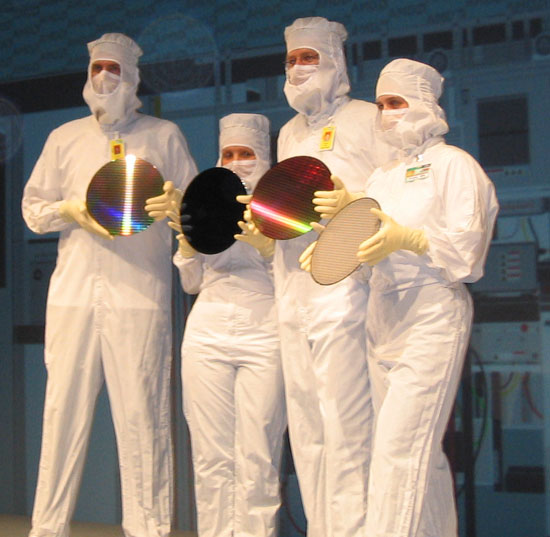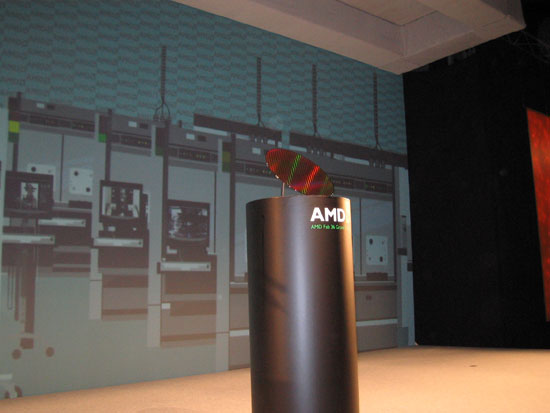AMD's Fab 36 Grand Opening - 90nm and 300mm in Germany
by Anand Lal Shimpi on October 14, 2005 7:50 AM EST- Posted in
- CPUs
AMD Draws a Crowd: German Chancellor Schröder Arrives
After the initial press conference we took a short bus ride to an outside tent where both Dr. Deppe and Dr. Ruiz gave a few words about Dresden and Fab 36, before handing the mic off to German Chancellor Gerhard Schröder.
One point to note was the constant mentioning of "fair competition" in all of Dr. Ruiz speeches, obviously referring to AMD's recent lawsuit against Intel. Dr. Ruiz also mentioned AMD's 50-by-15 goal; that by 2015, 50% of the world will be "connected", partially in thanks to an increase in production of AMD's products. Intel has also outlined their plans for 2015, which we've covered in the past.

German Chancellor Gerhard Schröder
Chancellor Schröder also made it a point to mention the importance of such a large investment in Dresden, being a part of former East Germany, while stressing that the incoming German government should make it a point to encourage similar investments in the future.
Chancellor Schröder also briefly touched on the topic of fair competition and how Germany's cooperation with AMD has been in the spirit of fair competition, also clearly in reference to AMD's recent lawsuit.

Governer of Saxony, Professor Dr. Georg Milbradt
Dresden is located in the German state of Saxony, and next up was the Governer of the State of Saxony, Professor Dr. Georg Milbradt. Professor Milbradt spoke of the history of Saxony from its humble beginnings to being a center for semiconductor manufacturing thanks to companies like AMD and Siemens.
Professor Milbradt's speech also took a political tone, as he stressed the importance of the new federal government to do even more to encourage investments such as AMD's in Dresden. He stressed that the investments are necessary in order to make Saxony and Dresden competitive in the EU and in the world.
Both Milbradt and Schröder hinted that AMD should definitely consider Dresden for their next fab plant, which Dr. Ruiz mentioned could potentially begin construction as early as 2008.

More 300mm wafers, we counted at least 5 today, that should be enough for at least a few Athlon 64 X2s.
The speeches were concluded with a ceremonial "raising of the wafer" as a 300mm wafer rose from the stage and was presented to Dresden, the state of Saxony and Dresden.

The events at Fab 36 in Dresden are just beginning, we're about to head to a Q&A session followed by some technical tracks and tours of the new plant.
AMD is hopefully going to present us with their future plans later today, which we've been looking forward to ever since Intel's IDF announcements. We'll see if AMD can deliver a more interesting look at their future than the ambiguity that we've been given in the past; stay tuned.










70 Comments
View All Comments
Spoonbender - Friday, October 14, 2005 - link
Am I the only one who's a bit disappointed by that? So they're a full year behind Intel on this?MrEMan - Friday, October 14, 2005 - link
And just how many of Intel's many fabs have actually been converted, and what is their schedule for conversion. With out knowing that how can one make a judgement as to how far behind AMD is?Also, what is more preferred: better processors across the board at 90 nm or lesser processors at 65 nm. If I recall correctly the concentration of heat goes up as the die size is reduced which would portend greater heat problems for Intel, not less, at least until they redesign based on the PIII/Pentium M higher IPC/lower clock speed internal designs.
Johnmcl7 - Friday, October 14, 2005 - link
If you read the articles on Intel's new 65nm you'll see the power usage and thermal dissipation is lower than the 90nm prescotts.John
Johnmcl7 - Friday, October 14, 2005 - link
As in their 65nm netburst processors, not the next generation P-m based designs.John
coldpower27 - Friday, October 14, 2005 - link
Themral density may be increased, by overall thermal output of processors on 65nm process is reduced compared to 90nm for NetBurst at least. That is why CPU's are equipped with heatspreaders to help disappate the heat over a large surface area.As long as the processor runs stable and reliably there should be no complaints.
The slower 65nm transition at Fab 36 is expected. AMD roadmaps don't indicate any 65nm products for the first half of 2006, with Windsors, Orleans & Manilla Socket M2 based processors still at 90nm node. Hopefully we will see some 65nm products on the roadmaps for 2nd half 2006, which is around the time of Intel introduction of 2nd Generation processors on 65nm tech namely Merom/Conroe.
nserra - Friday, October 14, 2005 - link
Remember that AMD processors are not made of the same "compounds" of Intel processors.Maybe AMD could also launch a 65nm based processor based on "compounds" of Intel processors.
As
Intel could "never" launch a 65nm based processor using AMD "compounds".
smn198 - Friday, October 14, 2005 - link
Hope this means cheaper processors as AMD is able to up output, reduce margins and force Intel to do the same but where can I get one of those wafers?ariafrost - Friday, October 14, 2005 - link
My AMD stock probably will jump today ;)Questar - Friday, October 14, 2005 - link
Why would it? This is not news, this "grand opening" has already been priced into the current price. Be aware this plant is not producing any sellable chips at this point.bigpimpatl - Friday, October 14, 2005 - link
ooooh nice =)